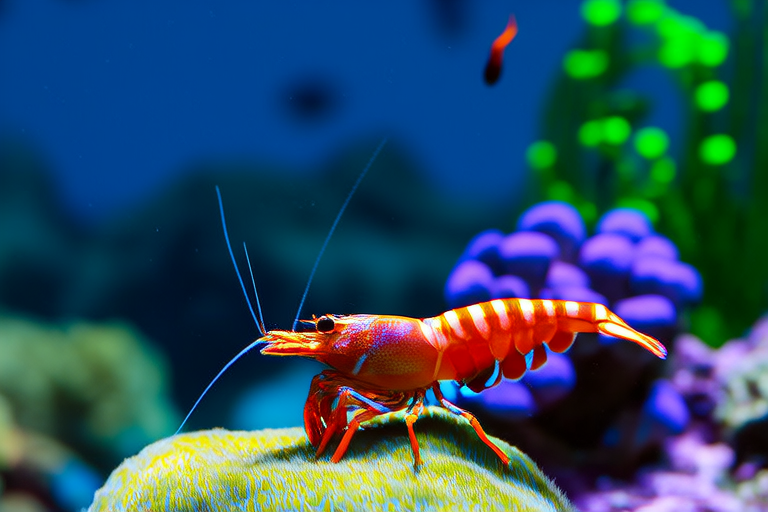From Ocean Floor to Aquarium: The Journey of Coral Shrimp
Welcome to an underwater odyssey that begins on the vibrant ocean floor and culminates in the serene confines of your home aquarium. This journey introduces you to the fascinating world of coral shrimp, exploring their diverse species, unique adaptations, and the challenges involved in bringing them from their natural habitats to your tank.
The Diverse World of Coral Shrimp
Coral shrimp, a subset of the Decapoda order, encompasses a variety of species that inhabit coral reefs around the globe. These creatures range in size from minuscule to slightly larger, with colors that can be as varied as the coral itself, from translucent white to vibrant reds and oranges. Each species plays a crucial role in the marine ecosystem, contributing to the health of the reef through symbiotic relationships with corals and other marine organisms.
One notable species is the Pontonides randalli, commonly known as the Randall’s shrimp. Found in the Indo-Pacific region, this shrimp has a striking red body with white spots, making it a favorite among aquarists. Another popular species is the Bathyspongicola spinosus, known for its spiky appearance and ability to live within sponge structures, aiding in the cleaning and maintenance of these sponges. These species, along with many others, form intricate webs of life within the coral reefs, providing essential services like nutrient cycling and waste management.
Adaptations for Thriving in Marine Environments
The harsh conditions of the ocean floor demand specific adaptations for survival. Coral shrimp have developed several physiological features to cope with their environment. For instance, they possess specialized appendages designed for grooming and cleaning, which help them maintain their habitat. Additionally, their exoskeletons are adapted to resist predation and environmental stressors, while their coloration often serves as camouflage against predators.
These adaptations also include behaviors that enhance their survival. Many coral shrimp exhibit nocturnal habits, emerging at night to feed and mate, thereby avoiding daytime predators. Their diet primarily consists of detritus, algae, and small planktonic organisms, which they efficiently gather using their specialized mouthparts. The symbiotic relationship between some species and their host corals or sponges further underscores their adaptability and ecological significance.
The Challenges of Collecting Coral Shrimp for Aquariums
Collecting coral shrimp for aquariums presents several challenges, primarily concerning sustainability and ethical considerations. Overfishing and habitat destruction pose significant threats to these delicate creatures. To mitigate these issues, responsible collectors employ sustainable practices such as selective harvesting, ensuring minimal impact on the reef environment.
Moreover, ethical considerations play a pivotal role in the collection process. Aquarists and collectors must adhere to guidelines set by regulatory bodies to prevent exploitation of marine resources. By supporting reputable suppliers who prioritize the well-being of marine ecosystems, we contribute to the conservation of these beautiful creatures.
The Acclimation Process: From Ocean to Aquarium
The transition from the ocean to an aquarium requires careful attention to detail. The first step involves acclimating the shrimp to the new water conditions. This typically entails floating the transport container in the aquarium water for about 15 minutes to equalize temperature differences. Afterward, a gradual introduction of aquarium water into the container ensures that the shrimp adjust to the chemical composition of their new environment.
Maintaining optimal water conditions is paramount. Parameters such as pH, salinity, and temperature must closely mimic those of the ocean. For most coral shrimp species, a pH range of 8.1 to 8.4, a salinity level of 32 to 35 ppt, and a temperature between 72°F and 82°F (22°C to 28°C) are ideal. Regular testing and adjustments are necessary to ensure stability.
Dietary needs also require attention. In the wild, coral shrimp feed on microorganisms and detritus. In captivity, they can thrive on a diet of commercial frozen or live foods such as brine shrimp, daphnia, and mysis shrimp. Supplementing their diet with algae wafers or spirulina-based foods can provide additional nutrients.
Tips for Maintaining a Healthy Environment
Creating a thriving environment for coral shrimp in your aquarium involves more than just providing food and clean water. Proper filtration systems are essential to maintain water quality, removing harmful substances and excess nutrients. Regular water changes, typically 10% to 20% every week, help keep the tank healthy.
In addition to water quality, the physical environment should mimic the natural habitat as closely as possible. Providing hiding places and ample space for swimming allows the shrimp to feel secure and active. Live rock and corals not only serve as decorations but also offer surfaces for the shrimp to graze on algae and other organic matter.
Aquarium owners should also monitor the behavior of their shrimp for signs of stress or illness. Rapid breathing, lethargy, or abnormal coloration may indicate underlying issues that need addressing. Consulting with a veterinarian specializing in aquatic animals can provide guidance on treatment options.
Maintaining a healthy environment for coral shrimp not only ensures their well-being but also enhances the aesthetic appeal of your aquarium. The vibrant colors and graceful movements of these creatures add a touch of the ocean’s magic to any home display.
Conclusion
The journey of coral shrimp from the ocean floor to your aquarium is one of adaptation, resilience, and care. Understanding their role in marine ecosystems, the challenges faced in their collection, and the steps required for successful acclimation enriches our appreciation of these remarkable creatures. By fostering a healthy environment in our tanks, we honor the beauty and importance of coral shrimp, celebrating their presence in our aquatic worlds.
